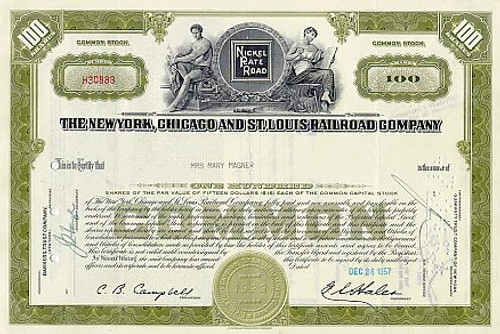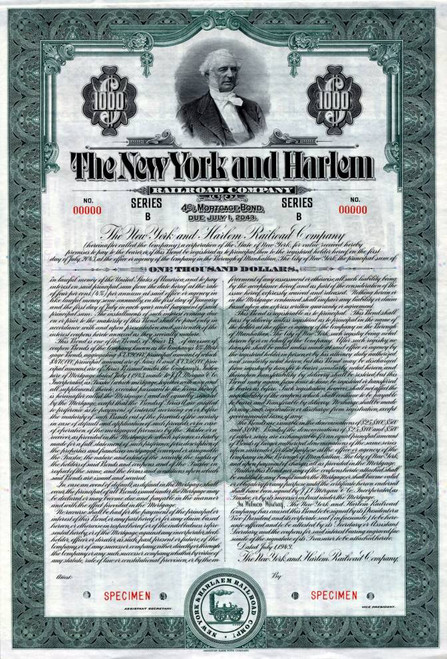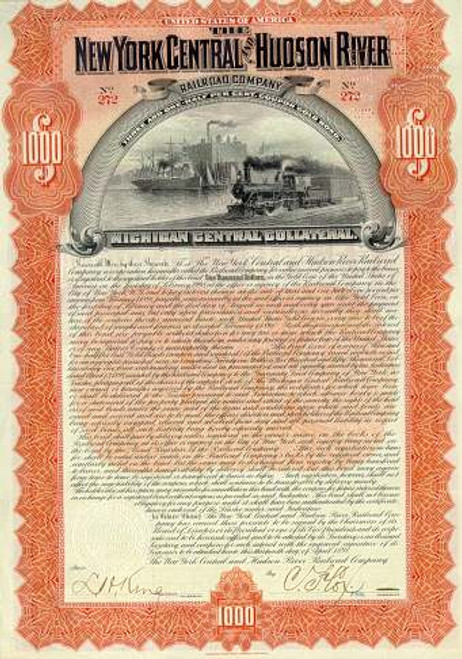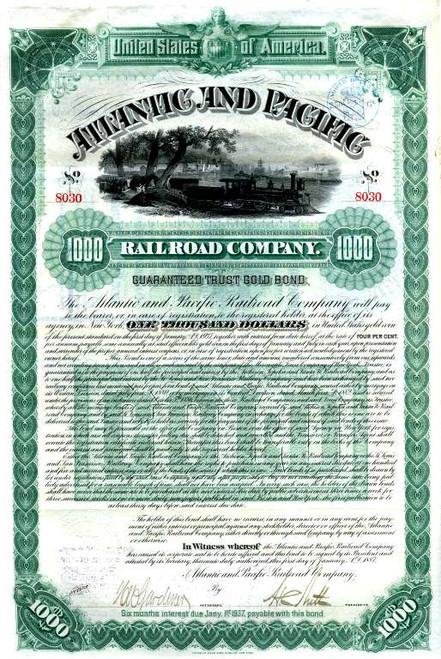Beautifully engraved specimen certificate from New York, Chicago, and St. Louis Railroad Company dated 1928. This historic document was printed by American Bank Note Company and has an ornate border around it with a vignette of a steam locomotive train. This item is over 87 years old. 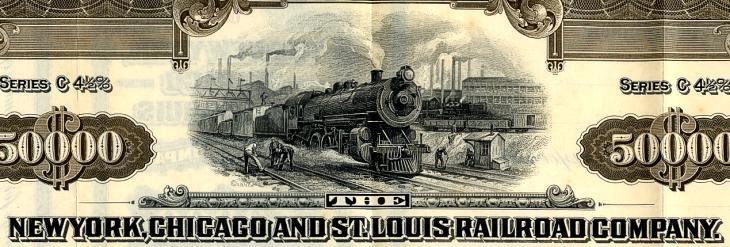
Certificate Vignette New York, Chicago and St. Louis Railroad Reporting marks NKP Locale New York to Chicago and St. Louis, MO Dates of operation 1881 1964 Successor line Norfolk and Western Track gauge 4 ft 8½ in (1435 mm) (standard gauge) Headquarters Cleveland, Ohio The New York, Chicago and St. Louis Railroad (AAR reporting mark NKP), abbreviated NYC&St.L, was a railroad that operated in the mid-central United States. Commonly referred to as the Nickel Plate Road, the railroad served a large area, including trackage in the states of New York, Pennsylvania, Ohio, Indiana and Illinois. Its primary connections included Buffalo, New York, Chicago, Cleveland, Ohio, Indianapolis, Indiana, St. Louis, Missouri and Toledo, Ohio. The Nickel Plate Railroad was constructed in 1881 along the South Shore of the Great Lakes connecting Buffalo, New York and Chicago to compete with the Lake Shore and Michigan Southern Railway. In 1964, the Nickel Plate Road and several other mid-western carriers were merged into Norfolk and Western Railway and the Nickel Plate Road was no more. The N&W was formed to be a more competitive and successful system serving 14 states and the Canadian province of Ontario on more than 7,000 miles (11,000 km) of railroad. The profitable N&W was itself combined with the Southern Railway, another profitable carrier, to form Norfolk Southern Corporation (NS) in 1982. The 25 years after the American Civil War more than doubled the existing American railroad track miles, changing the face of America forever. American railroads allowed products made in the East to be shipped to the expanding West less expensively than previously. This allowed for an economy of scale - larger, more efficient factories. The agricultural heartland of America was no longer confined to a market of single day's trip by wagon. Railroad and railroad construction became one of the largest industries during that era. By 1881, one out of 32 people in the United States was either employed by a railroad or engaged in railroad construction. Starting about 1877, two great railroad developers, William H. Vanderbilt and Jay Gould, began competing for the railroad traffic along the south shore of the Great Lakes. By 1878 William Vanderbilt had a monopoly on rail traffic between Buffalo, New York; Cleveland, Ohio; Detroit, Michigan; and Chicago, because he owned the only railroad between those cities - the Lake Shore and Michigan Southern Railway. In addition, he was the richest man in America at that time. By 1881 Jay Gould controlled about 15% of all U.S. railroad mileage, most of it west of the Mississippi River and he was considered the most ruthless financial operator in America. Gould's major railroad east of the Mississippi River was the 3350 mile (5400 km) Wabash, St. Louis and Pacific Railway (Wabash). The Wabash mainline ran from St. Louis, Missouri to Toledo, Ohio where it was forced to deliver its railroad traffic to William H. Vanderbilt's Lake Shore Railroad for deliver to the eastern United States. Jay Gould and William Vanderbilt together oversaw all east-west rail traffic in the mid-west. The owners (the Seney Syndicate) of a 350-mile (560 km) railroad, the Lake Erie and Western Railroad, were interested in tapping new sources of revenue. The stage was set for the creation of the New York, Chicago and St. Louis Railroad. Early years The Seney Syndicate met at Seney's New York bank and organized the New York, Chicago and St. Louis Railway Company on 3 February 1881. The original proposal for the NYC&St.L was a 340-mile (550 km) railroad west from Cleveland, Ohio to Chicago, Illinois with a 325-mile (525 km) branch to St. Louis, Missouri. On 13 April 1881 the New York, Chicago and St. Louis Railway Company bought the Buffalo, Cleveland and Chicago Railway, a railroad that been surveyed from the west side of Cleveland, Ohio to Buffalo, New York running parallel to Vanderbilt's Lake Shore and Michigan Southern Railway. The idea of an east-west railroad across northern Ohio was very popular with the people of Ohio. They wanted to break the high freight rates charged by Jay Gould and William Henry Vanderbilt. No one was less popular in Ohio than William Vanderbilt since the 29 December 1876 collapse of Lake Shore and Michigan Southern Railway's Ashtabula River trestle, where 64 people had been injured and 92 were killed or died later from injuries. Another reason for the popularity of the New York, Chicago and St. Louis Railway was the positive economic impact on cities that any new railroad went through at that time. During a newspaper war to attract the New York, Chicago and St. Louis the Norwalk, Ohio Chronicle Newspaper referred to the New York, Chicago and St. Louis as "... double-track nickel-plated railroad." The New York, Chicago and St. Louis adopted the nickname and it became better known as the Nickel Plate Road. It was decided to start building along the surveyed route between Cleveland, Ohio and Buffalo, New York rather than build the branch to St. Louis, Missouri. Five hundred days later the Nickel Plate's 513-mile (825 km) single-track mainline from Buffalo, New York to Chicago was complete. The railroad was estimated to require 90,000 long tons (80,000 metric tons) of steel rails, each weighing sixty pounds per yard (30 kg/m) and 1.5 million oak crossties. Additionally, the railroad required forty-nine major bridges. It was characterized by long sections of straight track, mild grades and impressive bridges. The Nickel Plate ran its first trains over the entire system on 16 October 1882. During construction, Vanderbilt and Gould had watched with great interest. If either of them could acquire the Nickel Plate, they could end the threat to their railroads. If the Nickel Plate remained independent it would be able to create a substantial dent in both entrepreneurs' railroad earnings. Vanderbilt tried to lower the value of the Nickel Plate by organizing a campaign to smear its reputation before a train ever ran on its tracks. If Vanderbilt was successful he could scare the Seney Syndicate into selling to him or drive the railroad company into bankruptcy. However, Vanderbilt's plan came with two important risks. If he slandered the line he risked chasing the Seney Syndicate into an alliance with Gould. The other risk was that his plan to smear the Nickel Plate's reputation might fail and it could quickly grow. Vanderbilt claimed the road was being built with substandard materials and it would use unsafe practices once completed. He succeeded in creating long-standing rumors about the line, but failed to devalue the company or scare the investors. The cost of construction was higher than expected and the Seney Syndicate began to negotiate with Gould to purchase the railroad, but unlike Vanderbilt, Gould lacked the capital. Frustrated at the failing talks, Gould broke off negotiations and gave up on his attempt to break Vanderbilt. The Lake Shore and Michigan Southern era In early 1881, Vanderbilt could have had the New York, Chicago and St. Louis Railway (or Nickel Plate) for one million dollars. He realized if he allowed Jay Gould to gain control of the Nickel Plate his monopoly on rail traffic from Toledo, Ohio - east would be broken. He decided he would do anything to keep the Nickel Plate out of Gould's hands. On 25 October 1882 (a few days after the first trains ran) the Seney Syndicate sold the Nickel Plate to Vanderbilt for 7.2 million dollars. Vanderbilt transferred it to his Lake Shore and Michigan Southern Railway. However, Vanderbilt had a problem: he could not run the business into the ground or it would fall into receivership and someone else would buy it. He could not close the Nickel Plate either because it cost a fortune to buy. So, the Nickel Plate Road did business, but just enough to keep it solvent. By the advent of the 1920s the Nickel Plate was an obscure line that earned its keep through the transfer of freight from other rail connections. During the same period Vanderbilt's Lake Shore and Michigan Southern prospered and expanded. Vanderbilt kept most of the rail traffic on his Lake Shore and Michigan Southern. Fewer trains on the Nickel Plate meant that they could move faster, so that is the railroad traffic they went after. By 1888 the Nickel Plate had been dubbed "The Meat Express Line." Observers at Fort Wayne, Indiana reported six long meat trains every night and a couple of fruit trains during the day. Vanderbilt consolidated many of his railroads into the New York Central Railroad. In 1915 Vanderbilt was found to be in violation of the federal antitrust laws because the New York Central had a controlling interest in the Nickel Plate. Over time the Nickel Plate had been reduced as a serious threat to competing lines and in return for operating concessions and access to certain stations, the New York Central sold the Nickel Plate to the Van Sweringen brothers of Cleveland, Ohio. The Van Sweringen era Oris Paxton Van Sweringen and his younger brother Mantis James Van Sweringen were real estate developers who constructed a rapid transit from their development at Shaker Heights, Ohio to downtown Cleveland. As early as 1909 the Van Sweringen brothers proposed a stub-end terminal on Public Square in downtown Cleveland. The Cleveland interurbans and traction companies were in favor of the new terminal and right-of-ways leading to it. The Nickel Plate was the key. It transversed Cleveland from east to west, had a high level crossing of the Cuyahoga River Valley, and it was adjacent to the proposed terminal. The Nickel Plate also provided natural route to the proposed terminal for the Van Sweringen's rapid transit and the other traction lines. Between 1890 and 1913 Cleveland had a four fold increase in population. Cleveland wanted to clean up the city and started many civic projects. Cleveland wanted to consolidate all of its railroad stations. The Lake Shore and Michigan Southern Railway, Pennsylvania Railroad, and Cleveland, Cincinnati, Chicago and St. Louis Railroad shared a crowded lakefront Union Station. The Erie Railroad, Baltimore and Ohio Railroad, Nickel Plate Road, and Lake Erie and Western Railroad all occupied separate stations on the north bluff of the Cuyahoga River, just south of downtown. The city also encouraged the railroads to build grade separation throughout the city. The Nickel Plate started a grade separation project on the East Side of Cleveland in 1909 and finished in 1913. Cleveland approved a bond issue in 1910 to "depress" the Nickel Plate through the most congested part of the West Side. The Lake Shore and Michigan Southern Railway was controlled by the New York Central Railroad's Alfred H. Smith, a close friend of the Van Sweringens. He had guided the Van Sweringens and even financed their rapid transit to Shaker Heights. The Attorney General of the United States advised the New York Central that its control of the Lake Shore and Michigan Southern and the Nickel Plate was in violation of the Federal antitrust laws in late 1915. Alfred Smith called his friends, the Van Sweringens on 1 February 1916 and offered them the Nickel Plate. They bought it for 8.5 million dollars on 13 April 1916. They only put up a little over half a million dollars but they controlled 75% of Nickel Plate's voting stock. The Van Sweringens had no intention of running the Nickel Plate. Alfred Smith was happy to give the Van Sweringens a vice-president of the New York Central, John Bernet, and some of his top men. Smith wanted to show that the Van Sweringens were not New York Central puppets, and the Nickel Plate needed to earn money to retire the $6.5 million in notes owed to the New York Central. NKP president John Bernet era This section is a stub. You can help by adding to it. The end of an era: merger with N&W, Norfolk Southern As the financial situation of American railroading continued to decline after World War II, the Nickel Plate Road together with the Wabash and several smaller carriers merged with the profitable Norfolk and Western on October 16, 1964. N&W had merged with long-time rival Virginian Railway in the Pocahontas coal region in 1959, and grew through the mergers with other rail carriers including the Nickel Plate and Wabash railroads with operations in adjacent areas of the eastern United States to form a more competitive and successful system serving 14 states and a province of Canada on more than 7,000 miles of road. The profitable N&W was itself combined with the Southern Railway, another profitable carrier, to form Norfolk Southern Corporation (NS) in 1982. Chicago terminals By 1897 the Nickel Plate had obtained trackage rights over the Lake Shore and Michigan Southern Railway from Grand Crossing to its own terminal on the east side of the LS&MS line to LaSalle Street Station, just north of Roosevelt Road (12th Street). By 1928 it used LaSalle. Origin of the Nickel Plate nickname The following is an excerpt from the book The Nickel Plate Road, A Short History of the New York, Chicago & St. Louis R.R. printed in 1954. The book is a record of an address given by Lynne L. White (a former president of the Nickel Plate) to the Newcomen Society of the United States, held in the ballroom of the Hotel Lawrence, Erie, Pa., November 11, 1954. Mr. White was guest of honor at this "1954 Lake Erie Dinner". Through northern Ohio, already served by four railroads, location of the line developed intense rivalries among cities. Three routes were surveyed and communities along each proposed route vied in the raising of public subscriptions to donate rights-of-way. The road's general offices at Cleveland frequently were besieged by delegations hoping to bring about the routing of the line through their communities. During these inter-city rivalries was born the nickname for the New York, Chicago and St. Louis - The Nickel Plate Road - which rapidly became the name most commonly used. Numerous legends have grown about when and how the name "Nickel Plate" was first applied. The accepted version is that it appeared first in an article in the Norwalk, Ohio, Chronicle of March 10, 1881. On that date the Chronicle reported the arrival of a party of engineers to make a survey for the "great New York and St. Louis double track, nickel plated railroad." Later, while attempting to induce the company to build the line through Norwalk instead of Bellevue, Ohio, the Chronicle again referred to the road as "nickel plated" - a term regarded as indicative of the project's glittering prospects and substantial financial backing. In 1882, the Nickel Plate recognized F.R. Loomis, owner and editor of the Norwalk Chronicle, as originator of the term and issued him Complimentary Pass No. 1. Thus Norwalk named the road - but Bellevue finally got it. History from Wikipeida and OldCompanyResearch.com.
About Specimens Specimen Certificates are actual certificates that have never been issued. They were usually kept by the printers in their permanent archives as their only example of a particular certificate. Sometimes you will see a hand stamp on the certificate that says "Do not remove from file". Specimens were also used to show prospective clients different types of certificate designs that were available. Specimen certificates are usually much scarcer than issued certificates. In fact, many times they are the only way to get a certificate for a particular company because the issued certificates were redeemed and destroyed. In a few instances, Specimen certificates we made for a company but were never used because a different design was chosen by the company. These certificates are normally stamped "Specimen" or they have small holes spelling the word specimen. Most of the time they don't have a serial number, or they have a serial number of 00000. This is an exciting sector of the hobby that grown in popularity over the past several years.

Certificate Vignette
About Specimens Specimen Certificates are actual certificates that have never been issued. They were usually kept by the printers in their permanent archives as their only example of a particular certificate. Sometimes you will see a hand stamp on the certificate that says "Do not remove from file". Specimens were also used to show prospective clients different types of certificate designs that were available. Specimen certificates are usually much scarcer than issued certificates. In fact, many times they are the only way to get a certificate for a particular company because the issued certificates were redeemed and destroyed. In a few instances, Specimen certificates we made for a company but were never used because a different design was chosen by the company. These certificates are normally stamped "Specimen" or they have small holes spelling the word specimen. Most of the time they don't have a serial number, or they have a serial number of 00000. This is an exciting sector of the hobby that grown in popularity over the past several years.




